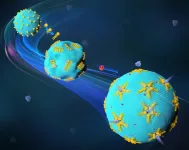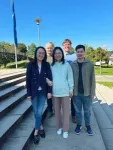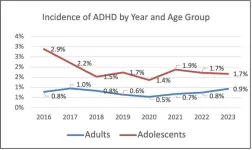(Press-News.org) Scientists at the University of Stuttgart have succeeded in controlling the structure and function of biological membranes with the help of "DNA origami". The system they developed may facilitate the transportation of large therapeutic loads into cells. This opens up a new way for the targeted administration of medication and other therapeutic interventions. Thus, a very valuable instrument can be added to the toolbox of synthetic biology. Prof. Laura Na Liu and her team published their findings in the journal Nature Materials (DOI: 10.1038/s41563-024-02075-9).
The shape and morphology of a cell play a key role in the biological function. This corresponds to the principle of "form follows function", which is common in modern fields of design and architecture. The transfer of this principle to artificial cells is a challenge in synthetic biology. Advances in DNA nanotechnology now offer promising solutions. They allow the creation of novel transport channels that are large enough to facilitate the passage of therapeutic proteins across cell membranes. In this emerging field, scientists such as Prof. Laura Na Liu, Director of the 2nd Physics Institute at the University of Stuttgart and Fellow at the Max Planck Institute for Solid State Research (MPI-FKF), have developed an innovative tool for controlling the shape and permeability of lipid membranes in synthetic cells. These membranes are made up of lipid bilayers that enclose an aqueous compartment and serve as simplified models of biological membranes. They are useful for studying membrane dynamics, protein interactions, and lipid behavior.
A milestone in the application of DNA nanotechnology
This new tool may pave the way for the creation of functional synthetic cells. The scientific work of Laura Na Liu aims to significantly influence the research and development of new therapies. Liu and her team have succeeded in using signal-dependent DNA nanorobots to enable programmable interactions with synthetic cells. "This work is a milestone in the application of DNA nanotechnology to regulate cell behavior," Liu says. The team works with giant unilamellar vesicles (GUVs), which are simple, cell-sized structures that mimic living cells. Using DNA nanorobots, the researchers were able to influence the shape and functionality of these synthetic cells.
New transport channels for proteins and enzymes
DNA nanotechnology is one of Laura Na Liu's main research areas. She is an expert in DNA origami structures — DNA strands that are folded by means of specifically designed shorter DNA sequences, so-called staples. The team of Liu used DNA origami structures as reconfigurable nanorobots that can reversibly change their shape and thereby influence their immediate environment in the micrometer range. The researchers found that the transformation of these DNA nanorobots can be coupled with the deformation of the GUVs and the formation of synthetic channels in the model GUV membranes. These channels allowed large molecules to pass through the membrane and can be resealed if necessary.
Fully artificial DNA structures for biological environments
"This means that we can use DNA nanorobots to design the shape and configuration of GUVs to enable the formation of transport channels in the membrane," says Prof. Stephan Nussberger, who is a co-author of this work. "It is extremely exciting that the functional mechanism of the DNA nanorobots on GUVs has no direct biological equivalent in living cells,” adds Nussberger.
The new work raises new questions: Could synthetic platforms - such as DNA nanorobots - be designed with less complexity than their biological counterparts, which would nevertheless function in a biological environment?
Understanding disease mechanisms and improving therapies
The new study is an important step in this direction. The system of cross-membrane channels, created by DNA nanorobots, allows an efficient passage of certain molecules and substances into the cells. Most importantly, these channels are large and can be programmed to close when needed. When applied to living cells, this system can facilitate the transportation of therapeutic proteins or enzymes to their targets in the cell. It thus offers new possibilities for the administration of drugs and other therapeutic interventions. "Our approach opens up new possibilities to mimic the behavior of living cells. This progress could be crucial for future therapeutic strategies," says Prof. Hao Yan, one of the co-authors of this work.
About Prof. Laura Na Liu, her team, and the authors of the study
Laura Na Liu is the Director of the 2nd Physics Institute at the University of Stuttgart, Fellow at the Max Planck Institute for Solid State Research (MPI-FKF), and one of the main authors of the study. The interdisciplinary research team includes members of several institutes of the University of Stuttgart: the 2nd Physics Institute, the Department of Biophysics at the Institute of Biomaterials and Biomolecular Systems and the Institute of Theoretical Physics IV. Also involved in the study is Prof. Hao Yan, a recipient of the Alexander von Humboldt Research Award. He is hosted by Liu's group and is doing research at the Biodesign Center for Molecular Design and Biomimetics at Arizona State University.
About the study
Sisi Fan, Shuo Wang, Longjiang Ding, Thomas Speck, Hao Yan, Stephan Nussberger, Na Liu. Morphological transformation and formation of membrane channels in synthetic cells through reconfigurable DNA nanotubes. Nature Materials, DOI: 10.1038/s41563-024-02075-9
END
New tool for synthetic biology
DNA nanorobots that can alter artificial cells
2025-01-13
ELSE PRESS RELEASES FROM THIS DATE:
Yu & Martin adapting mixed reality training programs to real-world scenes to enhance human-AI teaming in emergency responses
2025-01-13
Lap Fai (Craig) Yu, Associate Professor, Computer Science, College of Engineering and Computing, and Joel Martin, Associate Professor, Kinesiology, College of Education and Human Development, received funding for the project: “EAGER: TaskDCL: Adapting Mixed Reality Training Programs to Real-World Scenes to enhance Human-AI Teaming in Emergency Responses.”
This EArly-concept Grant for Exploratory Research (EAGER) project funds research that intends to speed up the development of mixed reality and artificial intelligence (AI) technologies to help ...
ExxonMobil donates $10 million to fund MD Anderson-led Be Well™ Beaumont initiative
2025-01-13
HOUSTON and BEAUMONT, TEXAS ― In an effort to improve public health and reduce cancer risk in East Texas, leaders in Beaumont are working with The University of Texas MD Anderson Cancer Center to launch Be Well™ Beaumont through a newly announced $10 million gift from ExxonMobil. Community members, collaborators and representatives from MD Anderson kicked off the 10-year initiative today in Beaumont.
Be Well Beaumont aims to promote wellness and to lower cancer risk among community members by providing them with cancer prevention education and tools. ...
Long reads successfully used to find genetic causes of rare diseases
2025-01-13
The cause of rare diseases is increasingly being detected through genome sequencing, which involves reading the entire human DNA by first breaking it into small pieces—short reads. Christian Gilissen, Lisenka Vissers, and colleagues found that a new technique using long reads is even more effective at detecting complex causes. They report that eighty to ninety percent of cases were detectable, as stated in the American Journal of Human Genetics.
Rare diseases are typically due to genetic causes. These causes are more and ...
X-ray flashes from a nearby supermassive black hole accelerate mysteriously
2025-01-13
One supermassive black hole has kept astronomers glued to their scopes for the last several years. First came a surprise disappearance, and now, a precarious spinning act.
The black hole in question is 1ES 1927+654, which is about as massive as a million suns and sits in a galaxy that is 100 million light-years away. In 2018, astronomers at MIT and elsewhere observed that the black hole’s corona — a cloud of whirling, white-hot plasma — suddenly disappeared, before reassembling months later. The brief though dramatic shut-off was a first in black hole astronomy.
Members of the MIT team have now caught the same black hole exhibiting ...
New research highlights trends in ADHD diagnoses
2025-01-13
New research identifies differing trends in attention-deficit/hyperactivity disorder (ADHD) diagnoses among adolescents and adults, including an increase among adults from 2020 to 2023. The study, published in the American Psychiatric Association Journal Psychiatric Research and Clinical Practice, found a significant downward trends in ADHD incidence among adults from 2016 to 2020 and adolescents from 2016 to 2018. The ADHD incidence rate remained stable for adolescents in subsequent years.
ADHD is a neurodevelopmental disorder involving inattention and/or hyperactivity and impulsivity that interferes with a person’s functioning and ability ...
United States dementia cases estimated to double by 2060
2025-01-13
A new study shows that the risk of developing dementia anytime after age 55 among Americans is 42%, more than double the risk reported by older studies.
That dementia risk translates into an estimated half-million cases this year, rising to 1 million new cases a year by 2060, according to the new work. Dementia involves progressive declines in memory, concentration, and judgment. The increasing number of cases is directly tied to the aging of the U.S. population. Beyond aging, a high risk of dementia is linked to genetic factors, as well as high rates of hypertension and diabetes, obesity, unhealthy diets, ...
“The biggest challenge is lacking public acceptance of wind turbines”
2025-01-13
In brief
In their overview study, the team of researchers led by Russell McKenna identified 14 key impact categories of wind energy.
They provide possible solutions for the identified impacts and suggest research priorities. More than 400 studies were included in the analysis.
The review paper, recently published in the journal Joule, provides guidance for future studies and policy decisions.
What is the study about, and what is its core message?
Russell McKenna: The study looks at the impacts of wind energy on the systems in which it is embedded; whether environmental and climate systems, socio-economic, ...
Six-month outcomes in the long-term outcomes after the multisystem inflammatory syndrome in children study
2025-01-13
About The Study: The results of this cohort study suggest that although children and young adults with multisystem inflammatory syndrome in children (MIS-C) can have severe disease during the acute phase, most recovered quickly and had a reassuring midterm prognosis.
Corresponding Author: To contact the corresponding author, Dongngan T. Truong, MD, email truongd@kidsheart.com.
To access the embargoed study: Visit our For The Media website at this link https://media.jamanetwork.com/
(doi:10.1001/jamapediatrics.2024.5466)
Editor’s Note: Please see the article for additional information, including other authors, author contributions and affiliations, ...
Global prevalence of sexual violence against children
2025-01-13
About The Study: The findings of this systematic review and meta-analysis highlight the burden of sexual violence against children worldwide based on current available evidence. There is a pressing need to enhance data collection efforts globally, especially in under-researched regions and for boys.
Corresponding Author: To contact the corresponding author, Antonio Piolanti, PhD, email antonio.piolanti@aau.at.
To access the embargoed study: Visit our For The Media website at this link https://media.jamanetwork.com/
(doi:10.1001/jamapediatrics.2024.5326)
Editor’s ...
Chances of quitting smoking improve with integrated care, including medication and counseling
2025-01-13
HOUSTON ― Smokers undergoing lung cancer screening may have the best chance of quitting if they receive integrated care, which includes medication and comprehensive counseling with tobacco treatment specialists, according to researchers at The University of Texas MD Anderson Cancer Center.
The study results, published today in JAMA Internal Medicine, demonstrated that integrated care outperformed other cessation methods with a nearly two-fold improvement in the odds of quitting. In this randomized clinical trial of 630 current smokers who were eligible for lung cancer screening, over ...
LAST 30 PRESS RELEASES:
Making lighter work of calculating fluid and heat flow
Normalizing blood sugar can halve heart attack risk
Lowering blood sugar cuts heart attack risk in people with prediabetes
Study links genetic variants to risk of blinding eye disease in premature infants
Non-opioid ‘pain sponge’ therapy halts cartilage degeneration and relieves chronic pain
AI can pick up cultural values by mimicking how kids learn
China’s ecological redlines offer fast track to 30 x 30 global conservation goal
Invisible indoor threats: emerging household contaminants and their growing risks to human health
Adding antibody treatment to chemo boosts outcomes for children with rare cancer
Germline pathogenic variants among women without a history of breast cancer
Tanning beds triple melanoma risk, potentially causing broad DNA damage
Unique bond identified as key to viral infection speed
Indoor tanning makes youthful skin much older on a genetic level
Mouse model sheds new light on the causes and potential solutions to human GI problems linked to muscular dystrophy
The Journal of Nuclear Medicine ahead-of-print tip sheet: December 12, 2025
Smarter tools for peering into the microscopic world
Applications open for funding to conduct research in the Kinsey Institute archives
Global measure underestimates the severity of food insecurity
Child survivors of critical illness are missing out on timely follow up care
Risk-based vs annual breast cancer screening / the WISDOM randomized clinical trial
University of Toronto launches Electric Vehicle Innovation Ontario to accelerate advanced EV technologies and build Canada’s innovation advantage
Early relapse predicts poor outcomes in aggressive blood cancer
American College of Lifestyle Medicine applauds two CMS models aligned with lifestyle medicine practice and reimbursement
Clinical trial finds cannabis use not a barrier to quitting nicotine vaping
Supplemental nutrition assistance program policies and food insecurity
Switching immune cells to “night mode” could limit damage after a heart attack, study suggests
URI-based Global RIghts Project report spotlights continued troubling trends in worldwide inhumane treatment
Neutrophils are less aggressive at night, explaining why nighttime heart attacks cause less damage than daytime events
Menopausal hormone therapy may not pose breast cancer risk for women with BRCA mutations
Mobile health tool may improve quality of life for adolescent and young adult breast cancer survivors
[Press-News.org] New tool for synthetic biologyDNA nanorobots that can alter artificial cells





